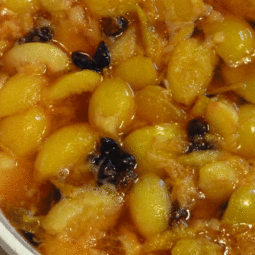We finally bottled this delicious brew a couple weeks ago and I had a panic when we popped the lid off the second fermented. The air inside smelled a little egg-y… which is usually a sign of vinegar… which is usually a sign that something went wrong…
I called my sister-in-law (hey Tara!) and talked it over with her. We couldn’t figure out what went wrong and the cider tasted fine. Her and my brother (hey Brian!) actually stopped over the next morning to sip it themselves. We concurred it was good enough for bottling. We added two cups of Asian pear juice that we froze from the press in September. I was hoping that would be enough sugar for the cider to undergo a third fermentation in the bottle, producing some natural carbonation.
After tasting the cider, I am happy to report that the egg-y smell is not there. It tastes like a smooth, delicious hard cider. If I did it over again, maybe I could double the amount of pear juice I added at the end because there is very, very little carbonation. I don’t mind a lack of carbonation, so it doesn’t really bother me any.
I’m thinking next year we could ferment a batch of cider with Asian pears, then follow up with another round using European pears. I think they fruit about a month apart, which means our primary fermenter will be available to start a new batch.
How much cider did we end up with? We filled nine 16 oz. flip-top bottles, thirteen 1-liter flip-top bottles, and twelve 22 oz bottles. That is about 837 ounces of delicious homebrew for us to enjoy this winter. We’re itching to move onto beer though, so expect some new projects over the next couple months!







 This cluster was about the siz
This cluster was about the siz




 I start with a
I start with a


837 bottles! Yum! Can I be your friend?
Oops, 837 ounces. We’ll still share with you though Christian
Yeast that ferment at cooler temperatures produce less fruity esters but usually produce more sulfur compounds (see http://www.howtobrew.com/section1/chapter10.html). This can make your cider smell like rotten eggs for a while but the smelly compounds vent with time — usually leaving a smooth tasting beverage behind. I hope this helps.
Hello,
I can answer you what went wrong with the rotten egg / hydrogen sulfide smell. It all comes down to sanitation, everything must be 100% decontaminated and rinsed out. That includes your transfer tubes.
Now, it depends on how you start your siphoning process, if you use your mouth to suck the must / wort down the tube to start siphoning make sure you brush your teeth with an organic toothpaste and use a non sulpher / sulfer based mouthwash.
Also, the air lock on the primary fermentation must stay full at all times, while it’s fermenting and just before you put it into secondary fementation.
I recommend using two 6.5 glass carboys and put a black trash bag over the body and part of the neck of the carboy when brewing. The light can actually harm the yeast as it’s brewing, as funny as it sounds.
Try to allow the brew to do it thing in a warm dark place, that is of course dependent purely on the type of yeast you use, too.
Most wine yeast like it at a certain temperature, as does ale, let alone a lager yeast (which prefers 50 to 60 degrees for primary fermentation).
Also, adding strong sulfite solution, too much of it can also mess up your brew, there are other ways to sterilze your bottles and other equipment that doesn’t add to the taste.
Note:
Use the most pure water possible from a artisian water well, that way you can rule out other bio-compounds in the water that can cause corruption of the fermentation process.